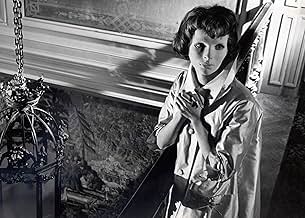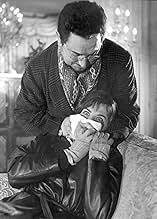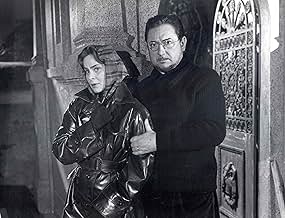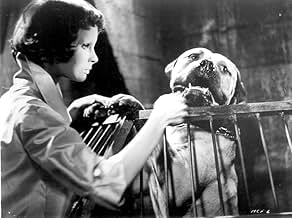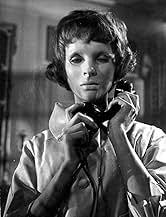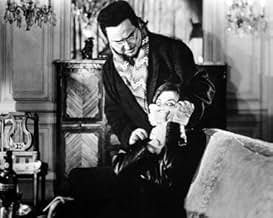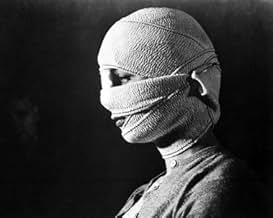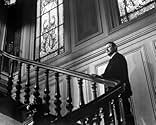CALIFICACIÓN DE IMDb
7.6/10
38 k
TU CALIFICACIÓN
Un cirujano causa un accidente que desfigura a su hija, y toma medidas extremas para darle una nueva cara.Un cirujano causa un accidente que desfigura a su hija, y toma medidas extremas para darle una nueva cara.Un cirujano causa un accidente que desfigura a su hija, y toma medidas extremas para darle una nueva cara.
- Dirección
- Guionistas
- Elenco
Charles Blavette
- L'homme de la fourrière
- (escenas eliminadas)
- (as Blavette)
Charles Bayard
- Un homme à la conférence
- (sin créditos)
Gabrielle Doulcet
- Une admiratrice du docteur Génessier
- (sin créditos)
Opiniones destacadas
A brilliant surgeon, Dr. Génessier, helped by his assistant Louise, kidnaps nice young women. He removes their faces and tries to graft them onto the head on his beloved daughter Christiane, whose face has been entirely spoiled in a car crash.
The mask was really good. The way it is blank, but clearly fits to the contours of her face... it completely destroys her identity, makes it like she does not even exist as a person. I would not go so far as to say she looks worse with it on than off, but it makes her less than human for sure.
While some of the story is a bit slow, it is overall a quite strong story... part horror, part drama and part detective story. I am not surprised that many horror historians consider it among the greatest films ever made in the genre.
The mask was really good. The way it is blank, but clearly fits to the contours of her face... it completely destroys her identity, makes it like she does not even exist as a person. I would not go so far as to say she looks worse with it on than off, but it makes her less than human for sure.
While some of the story is a bit slow, it is overall a quite strong story... part horror, part drama and part detective story. I am not surprised that many horror historians consider it among the greatest films ever made in the genre.
Though EYES WITHOUT A FACE is indeed a horror film, it is also a dark tragedy. Doctor Genessier (Pierre Brasseur) and his daughter, Christiane (Edith Scob) were involved in a terrible accident, leaving Christiane in the condition suggested by the title. Now, her father is driven to fix what he has done. He is aided by his faithful cohort, Louise (Alida Valli), who lures women to their fate.
Through hideous trial and error, involving several unwary, female "subjects", Genessier is willing to destroy others in order to restore his daughter's beauty. What he really seeks is redemption, and relief from his own feeling of unfathomable guilt. His obsession to restore what he has broken makes him oblivious to all else. For Genessier, the end truly does justify the means.
For her part, Christiane is a virtual prisoner in their enormous house, doomed to wear a doll-like mask, and wander about like a ghost. Not so surprisingly, this all leads to a catastrophic conclusion. This film shocked audiences and inspired a generation of filmmakers. It holds up solidly to this day...
Through hideous trial and error, involving several unwary, female "subjects", Genessier is willing to destroy others in order to restore his daughter's beauty. What he really seeks is redemption, and relief from his own feeling of unfathomable guilt. His obsession to restore what he has broken makes him oblivious to all else. For Genessier, the end truly does justify the means.
For her part, Christiane is a virtual prisoner in their enormous house, doomed to wear a doll-like mask, and wander about like a ghost. Not so surprisingly, this all leads to a catastrophic conclusion. This film shocked audiences and inspired a generation of filmmakers. It holds up solidly to this day...
Georges Franju's atmospheric masterpiece is a tapestry of contradictions. Eyes Without a Face is a compelling tale of sadism that has an astute tenderness at the same time. A film that will disgust you with it's macabre imagery, yet simultaneously mesmerise you with it's beauty; a seething tale of love, fashioned by extreme guilt. Through the Gothic confines of a grandiose mansion, Franju has taken ideas from classic stories such as 'Frankenstein' and constructed a dream like surrealistic fantasy that has inspired legions of filmmakers since: from obvious inspirations like Jess Franco's The Awful Dr Orlof, all the way to the full blown Hollywood action fest, Face/Off; Eyes Without a Face stands out as one of cinema's most important, yet most overlooked films. The central story is a deliriously simple tale of vanity, guilt and redemption; yet one that is lent a great depth from it's cast of central characters. Doctor Génessier, guilt ridden over a car accident that left his beloved daughter, Christiane, with a destroyed face uses his assistant to kidnap young girls in an attempt to reconstruct her ruined features. The good doctor peels the faces from his victims and grafts them over the ruined features of his young daughter. However, the experiments are a continual failure but, motivated by a strong sense of guilt, Doctor Génessier must keep trying.
The doctor himself is a masterpiece of horror film villainy. Unlike many mad scientists since, the doctor here is firmly placed within reality which makes his motivations easy to believe and therefore the horror all the more fascinating. He is supported by his assistant, Louise; a fellow web of intrigue. Louise isn't the normal mad doctor's assistant; she isn't deformed, or demented but rather a cunning, malevolent and cerebral predator; gathering her victims to aid the doctor's latest experiment. The real masterpiece of characterisation, however, comes from the central character; the disfigured tragedy herself, Christiane. The scenes that see her float around in her mask gown are some of the most memorable ever brought to the screen. While wearing her mask, Christiane represents both life and death. The mask itself is stagnant and lifeless, but the eyes beneath the mask are full of life's beauty, giving the young girl a surrealistic look that epitomises the film in that it's hard to place; is it beautiful, or revolting; good or evil?
This film is a rare treat in that it's actually frightening. Eyes Without a Face taps into the viewer's fears by presenting us with a situation that is terrifying because it involves a central character living with horror. You can have all the maniacs with all the weapons you can think of; but it doesn't compare to having to go to bed every night with a face that is scarred beyond redemption. A fate worse than death, I'm sure you'll agree. This premise is given conviction through a stark and constantly foreboding atmosphere, which comes as a result of Eugen Shuftan's magnificent cinematography. The film has a crisp and clean look, which brilliantly offsets the macabre scenes that it is capturing. Thankfully, Georges Franju also seems keen to keep the focus on the surreal horror aspects of the story, which is shown by the way that he rushes through the police investigation that stems from the doctor's experiments. The film also features a striking and memorable musical score. The music sounds like it wouldn't be out of place in a carnival or circus, which fits the movie brilliantly as it covers the weird and wonderful imagery that we are treated to on screen.
Overall, Eyes Without a Face is a magnificent expression of the horror genre. The creativity and beauty of the film are sure to delight anyone who encounters it, and this is as important and as breathtaking as anything cinema has to offer. All I can say is that the word 'masterpiece' was added to the English language with this film in mind.
The doctor himself is a masterpiece of horror film villainy. Unlike many mad scientists since, the doctor here is firmly placed within reality which makes his motivations easy to believe and therefore the horror all the more fascinating. He is supported by his assistant, Louise; a fellow web of intrigue. Louise isn't the normal mad doctor's assistant; she isn't deformed, or demented but rather a cunning, malevolent and cerebral predator; gathering her victims to aid the doctor's latest experiment. The real masterpiece of characterisation, however, comes from the central character; the disfigured tragedy herself, Christiane. The scenes that see her float around in her mask gown are some of the most memorable ever brought to the screen. While wearing her mask, Christiane represents both life and death. The mask itself is stagnant and lifeless, but the eyes beneath the mask are full of life's beauty, giving the young girl a surrealistic look that epitomises the film in that it's hard to place; is it beautiful, or revolting; good or evil?
This film is a rare treat in that it's actually frightening. Eyes Without a Face taps into the viewer's fears by presenting us with a situation that is terrifying because it involves a central character living with horror. You can have all the maniacs with all the weapons you can think of; but it doesn't compare to having to go to bed every night with a face that is scarred beyond redemption. A fate worse than death, I'm sure you'll agree. This premise is given conviction through a stark and constantly foreboding atmosphere, which comes as a result of Eugen Shuftan's magnificent cinematography. The film has a crisp and clean look, which brilliantly offsets the macabre scenes that it is capturing. Thankfully, Georges Franju also seems keen to keep the focus on the surreal horror aspects of the story, which is shown by the way that he rushes through the police investigation that stems from the doctor's experiments. The film also features a striking and memorable musical score. The music sounds like it wouldn't be out of place in a carnival or circus, which fits the movie brilliantly as it covers the weird and wonderful imagery that we are treated to on screen.
Overall, Eyes Without a Face is a magnificent expression of the horror genre. The creativity and beauty of the film are sure to delight anyone who encounters it, and this is as important and as breathtaking as anything cinema has to offer. All I can say is that the word 'masterpiece' was added to the English language with this film in mind.
At the time 'Les yeux sans visage' was released, the film was not very popular and faced common rejection by the critics. Regardless of those dis-affirmations, it raised to the position of a classic in the horror genre. Franju - one of the founders of the legendary Cinemathèque Française - succeeded in an intriguing way to make film history sensible as a source of inspiration of an entirely peculiar vision.
The clinic of Dr. Génessier (P. Brasseur) is located not very far from Paris. Famous as a specialist in skin grafting, nobody foreshadows that the scientific ambition of the surgeon is incident with a horrifying secret: Since an accident has destroyed the face of Génessier's daughter, Christiane (Scob), the doctor does everything to reconstruct her beauty. With the help of his assistant Louise (Valli) he clucks young women in his remote mansion, benumbs them and makes them a victim of a macabre surgical operation. In a hidden operating room in the basement of his house, Génessier removes the facial skin and transplants it on Christiane's face. Without lasting successes.
That Franjus film has not suffer losses from its immensely disturbing effects is because of, if nothing else, the camera work of Eugen Schüfftans. His brilliant black and white shots resurrects the bright dark of the expressionist German silent film. It imparts Villa Génessier a threatening life of it's own, transmutes it in a mazy horror house which seems like one can not escape. The shadows of the stairway handrails lay on everybody who enters the building like grids and makes him optically a prisoner of Génessier's delusion, mostly his daughter Christiane. Cut from a real life she haunts through the paternal ruins, the garbled face concealed behind a white porcelain mask, whose sad expression seems to nail the doom of the young woman.
Christiane's mask also points out a central principle of formation of the film: It's suspense results substantially from the interaction of visible and invisible things, of showing and dissembling. Franju subtly creates a nightmarish atmosphere that evokes the horror of Génessier's actions, but never makes it explicitly in the first instance - only to show it the viewer more pitilessly: When the surgeon unprovided cuts into the juvenilely beautiful face of one of his victims. This moment of shocking intensity reminds of the razor blade cut through the woman's eye of Bunuel's surrealistic classic 'Un chien andalou' (1929). With the same zest to provoke, Franju also presents the result of an ostensibly succeeded operation: A sober sequence of photographs shows, commented by Génessier off-stage, at first Christiane's angelically delicate face, then how the transplanted skin becomes patchy a few days later, splits open and two weeks later dies off. The cruelty of those two sequences exposes Génessier as a perverted, pestilent doctor and his paternal love as brutal obsession. The attempt to give his daughter a new face means at the same time to erase her identity, to create the ideal woman.
'Les yeux sans visage' remains in the memory of the viewer as one of the rare places on the imaginary continent, phantasmagoric and exigent with ample suspense and shocking details, a perfect alchemy of horror and allegoric poesy whereby one of the most beautiful horror films came into being.
The clinic of Dr. Génessier (P. Brasseur) is located not very far from Paris. Famous as a specialist in skin grafting, nobody foreshadows that the scientific ambition of the surgeon is incident with a horrifying secret: Since an accident has destroyed the face of Génessier's daughter, Christiane (Scob), the doctor does everything to reconstruct her beauty. With the help of his assistant Louise (Valli) he clucks young women in his remote mansion, benumbs them and makes them a victim of a macabre surgical operation. In a hidden operating room in the basement of his house, Génessier removes the facial skin and transplants it on Christiane's face. Without lasting successes.
That Franjus film has not suffer losses from its immensely disturbing effects is because of, if nothing else, the camera work of Eugen Schüfftans. His brilliant black and white shots resurrects the bright dark of the expressionist German silent film. It imparts Villa Génessier a threatening life of it's own, transmutes it in a mazy horror house which seems like one can not escape. The shadows of the stairway handrails lay on everybody who enters the building like grids and makes him optically a prisoner of Génessier's delusion, mostly his daughter Christiane. Cut from a real life she haunts through the paternal ruins, the garbled face concealed behind a white porcelain mask, whose sad expression seems to nail the doom of the young woman.
Christiane's mask also points out a central principle of formation of the film: It's suspense results substantially from the interaction of visible and invisible things, of showing and dissembling. Franju subtly creates a nightmarish atmosphere that evokes the horror of Génessier's actions, but never makes it explicitly in the first instance - only to show it the viewer more pitilessly: When the surgeon unprovided cuts into the juvenilely beautiful face of one of his victims. This moment of shocking intensity reminds of the razor blade cut through the woman's eye of Bunuel's surrealistic classic 'Un chien andalou' (1929). With the same zest to provoke, Franju also presents the result of an ostensibly succeeded operation: A sober sequence of photographs shows, commented by Génessier off-stage, at first Christiane's angelically delicate face, then how the transplanted skin becomes patchy a few days later, splits open and two weeks later dies off. The cruelty of those two sequences exposes Génessier as a perverted, pestilent doctor and his paternal love as brutal obsession. The attempt to give his daughter a new face means at the same time to erase her identity, to create the ideal woman.
'Les yeux sans visage' remains in the memory of the viewer as one of the rare places on the imaginary continent, phantasmagoric and exigent with ample suspense and shocking details, a perfect alchemy of horror and allegoric poesy whereby one of the most beautiful horror films came into being.
Georges Franju's version of a mad scientist trying to play God tells about a brilliant but controlling and obsessive doctor who is trying to restore the face of his own beloved daughter that was horribly disfigured in a car accident caused by his reckless driving. He requires tissues of recently deceased young women that look like his daughter and he is not going to wait for them to die in an accident - he creates the accidents with help of his loyal secretary/nurse/lover/former patient Louise (Alida Valli of "The Third Man") who kidnaps the unsuspecting girls and brings them to the secluded mansion in one of Paris's suburbs where Doctor Génessier is ready to perform the fascinating and horrifying surgeries.
"Eyes without a Face" is a very impressive, classy picture that has inspired many later horror movies. The music by Maurice Jarr adds to the uneasy and creepy atmosphere - it makes you feel like on the never-stopping ominous merry-go-round and you can't get off it.
"Eyes without a Face" is a very impressive, classy picture that has inspired many later horror movies. The music by Maurice Jarr adds to the uneasy and creepy atmosphere - it makes you feel like on the never-stopping ominous merry-go-round and you can't get off it.
¿Sabías que…?
- TriviaDuring the original release of the film in the UK in 1960, an English film critic for "The Spectator" was nearly fired for writing a positive review of it after the general critical reaction to it had been negative.
- ErroresWhen she is not wearing it, Christiane's mask is very thick and heavy and would only seem to cover her face. When she puts it on, however, it is very thin, close-fitting, and seamlessly covers her jawline and the underside of her chin, revealing that the mask itself is a prop while the actress probably wears a combination of makeup and prosthetics.
- Citas
Christiane Génessier: My face frightens me. My mask frightens me even more.
- Versiones alternativasThe film's original release in the U.S. in 1962 was dubbed in English, edited and re-titled "The Horror Chamber of Dr. Faustus". The surgery scene was edited for content, while any and all scenes that made Dr. Genessier seem to be sympathetic (particularly the scene where he cares for a sick boy) were cut.
- ConexionesFeatured in Cinéma, de notre temps: Georges Franju, le visionnaire (1996)
Selecciones populares
Inicia sesión para calificar y agrega a la lista de videos para obtener recomendaciones personalizadas
- How long is Eyes Without a Face?Con tecnología de Alexa
Detalles
Taquilla
- Total en EE. UU. y Canadá
- USD 58,565
- Fin de semana de estreno en EE. UU. y Canadá
- USD 19,628
- 2 nov 2003
- Total a nivel mundial
- USD 62,793
- Tiempo de ejecución1 hora 30 minutos
- Color
- Relación de aspecto
- 1.66 : 1
Contribuir a esta página
Sugiere una edición o agrega el contenido que falta

![Ver Tráiler [OV]](https://m.media-amazon.com/images/M/MV5BOGQ0MzNjNTYtYTViNC00NjVjLWI2MDEtYTczMzJjMTZlZDUwXkEyXkFqcGdeQXRyYW5zY29kZS13b3JrZmxvdw@@._V1_QL75_UY281_CR0)
